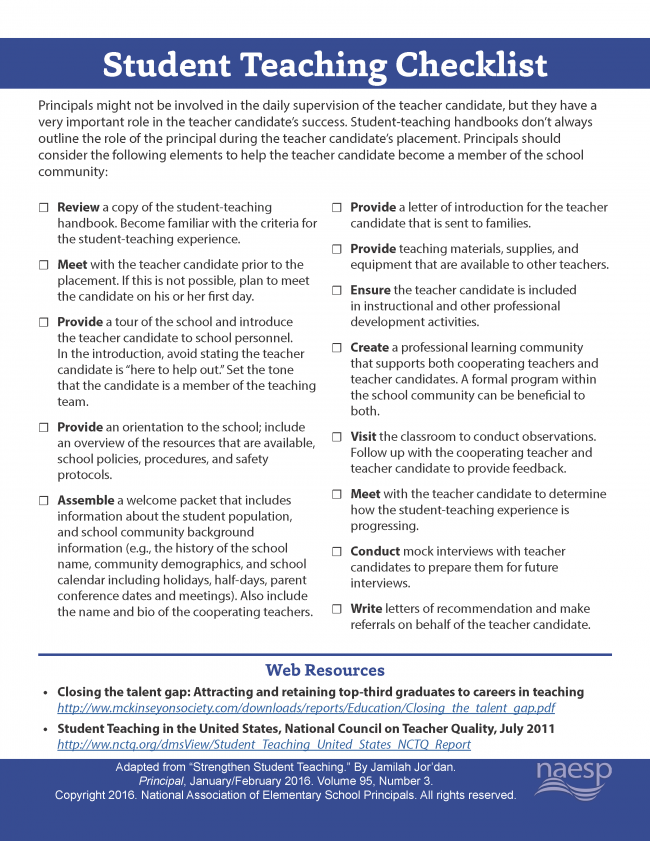Student Teachers: There’s a Checklist for That
By Jamilah R. Jor’dan Communicator February 2016, Volume 39, Issue 6
By Jamilah R. Jor’dan
Communicator
February 2016, Volume 39, Issue 6
Click here for PDF version
Supporting the emotional needs of teacher candidates and smoothing their transition in your school is essential. This important milestone, which is considered the most valuable and memorable experience candidates have as they develop into teachers, is both exciting and challenging because it places the teacher candidate in unfamiliar situations.
Principals might not be involved in the daily supervision of the teacher candidate, but they have a very important role in the teacher candidate’s success. Student-teaching handbooks don’t always outline the role of the principal during the teacher candidate’s placement. Principals should consider the following elements to help the teacher candidate become a member of the school community.
- Review a copy of the student-teaching handbook. Become familiar with the criteria for the student-teaching experience.
- Meet with the teacher candidate prior to the placement. If this is not possible, plan to meet the candidate on his or her first day.
- Provide a tour of the school and introduce the teacher candidate to school personnel. In the introduction, avoid stating the teacher candidate is “here to help out.” Set the tone that the candidate is a member of the teaching team.
- Provide an orientation to the school; include an overview of the resources that are available, school policies, procedures, and safety protocols.
- Assemble a welcome packet that includes information about the student population, and school community background information (e.g., the history of the school name, community demographics, and school calendar including holidays, half-days, parent conference dates and meetings). Also include the name and bio of the cooperating teachers.
- Provide a letter of introduction for the teacher candidate that is sent to families.
- Provide teaching materials, supplies, and equipment that are available to other teachers.
- Ensure the teacher candidate is included in instructional and other professional development activities.
- Create a professional learning community that supports both cooperating teachers and teacher candidates. A formal program within the school community can be beneficial to both.
- Visit the classroom to conduct observations. Follow up with the cooperating teacher and teacher candidate to provide feedback.
- Meet with the teacher candidate to determine how the student-teaching experience is progressing.
- Conduct mock interviews with teacher candidates to prepare them for future interviews.
- Write letters of recommendation and make referrals on behalf of the teacher candidate.
*Read the full article, “Strengthen Student Teaching” from the January/February 2016 issue of Principal magazine.
—
Copyright © 2016. National Association of Elementary School Principals. No part of the articles in NAESP magazines, newsletters, or website may be reproduced in any medium without the permission of the National Association of Elementary School Principals. For more information, view NAESP’s reprint policy.


